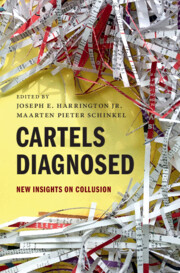Book contents
- Cartels Diagnosed
- Cartels Diagnosed
- Copyright page
- Contents
- Figures
- Tables
- Contributors
- Introduction
- 1 Entry Barriers, Personal Relationships, and Cartel Formation
- 2 “Now You Are Asking for a Real War!”
- 3 Coordinating Fuel Surcharges
- 4 Price Fixing or Fixing Competition?
- 5 The Role of Platforms for Facilitating Anticompetitive Communication
- 6 Collusion with Non-express Communication
- 7 Cartel Instability and Price Wars
- 8 Coordinated Rebate Reductions and Semi-collusion
- 9 Average Bid Auction Format Facilitates Bidding Rings
- 10 The Challenges of Cartelization with Many Products and Ongoing Technological Advancements
- 11 Two Cartels in the Supply Chain
- 12 Is it Collusion or Competition behind Price Parallelism?
- References
1 - Entry Barriers, Personal Relationships, and Cartel Formation
Generic Drugs in the United States*
Published online by Cambridge University Press: 06 December 2024
- Cartels Diagnosed
- Cartels Diagnosed
- Copyright page
- Contents
- Figures
- Tables
- Contributors
- Introduction
- 1 Entry Barriers, Personal Relationships, and Cartel Formation
- 2 “Now You Are Asking for a Real War!”
- 3 Coordinating Fuel Surcharges
- 4 Price Fixing or Fixing Competition?
- 5 The Role of Platforms for Facilitating Anticompetitive Communication
- 6 Collusion with Non-express Communication
- 7 Cartel Instability and Price Wars
- 8 Coordinated Rebate Reductions and Semi-collusion
- 9 Average Bid Auction Format Facilitates Bidding Rings
- 10 The Challenges of Cartelization with Many Products and Ongoing Technological Advancements
- 11 Two Cartels in the Supply Chain
- 12 Is it Collusion or Competition behind Price Parallelism?
- References
Summary
◦ This case study of generic drug markets illustrates the importance of interpersonal relationships in forming a cartel.
◦ Price fixing began in 2013 when Teva Pharmaceuticals, the world’s leading generic drugmaker, hired Nisha Patel to be the Director of Strategic Customer Marketing. Ms. Patel was tasked with “price increase implementation” and her approach to raising prices was to form an unlawful agreement with competitors to raise prices. She was well placed to engage in this activity as she had close ties to key salespeople at the major generic drugmakers due to having served as Director of Global Generic Sourcing for one of the largest US drug distributors.
◦ Cartels formed in about 90 percent of markets where she had close ties to all market participants, but only about 20 percent of markets where she lacked such relationships.
◦ The effects of collusive behavior persisted long after the cartel’s discovery. Though the conspirators discontinued direct communications after learning about the investigation, the evidence is that collusive prices persisted for many years afterwards.
◦ Collusion did induce some entry but its impact proved limited in these regulated markets. Many cartelized markets did not attract any entry, and the markets with entry saw a delay of two to four years before production started.
- Type
- Chapter
- Information
- Cartels DiagnosedNew Insights on Collusion, pp. 12 - 43Publisher: Cambridge University PressPrint publication year: 2025

